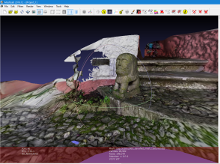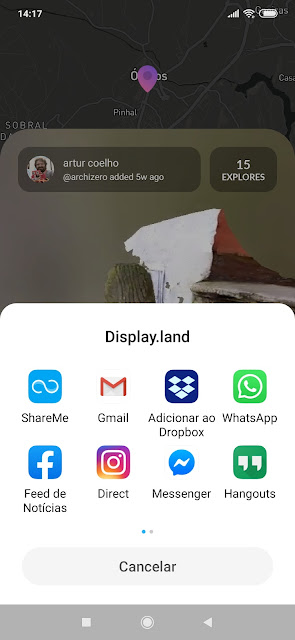

About 60 km beyond Lisbon, Óbidos is a popular tourist attraction. Visitors are enchanted by this well preserved medieval village, with quaint white-walled houses enclosed inside a castle. Most of them don't stray beyond the main street (actually, the portuguese name means straight street) with its cafes, beverages, souvenir and bric a brac stores and bookstores. Óbidos plans to be the portuguese version of Hay on Wye, a bookish village, and has a lot of bookstores and an ambitious literary festival. But the best delights of this village can be found only by straying from the main path. Exploring the medieval alleyways reveals fascinating and very photographable architectural details.
Criatura medieva by Artur Coelho on Sketchfab
One that continuously attracts my eyes is this strange creature. It sits, like a guarding dog, at the entrance steps of an old house. I don't know how old it is. Looks very weathered, ancient and not the fake old sometimes found on these sort of places. I also don't know what creature it is. My mythology fails me. Doesn't look like a dog, dragon, lion, chimaera or any other medievalesque inspiration. The most salient feature is its large head, with a human like face. I'm fascinated by this sculpture, and during one of my visits to the bookshops in Óbidos, I thought, why can't I have this in my desk, looking at me while I work? And with 3d scanning and printing, this is easy to do.
 |
| Scan: open Display.land app, and press the plus button. |
First thing is scanning the statue. Scanning from photographs is a tricky but powerful technique, that requires computers far more powerful than my old laptop. But today, there are some mobile apps that bring photogrammetry into mobile devices. Display.land is one of the most recent, and actually quite powerful. Runs on middle to top range Android phones, and it's very easy to use for 3D scanning. From my experience, results are better with human-scale subjects: statutes, environments, architectural details, people and objects, or building facades. Small objects don't give good results.
 |
| Press begin, and walk around the object. As soon as the slider reaches the first mark, the algorithm has enough information to return a valid scan. |
So, onwards. With my mid-range mobile, and a data connection, I start to scan this object. The trick is to capture multiple points of view that give the algorithm an idea of the shape of the objects. There are several ways to do it, my favorite is to walk around the object several times, in a spiral path, from bottom to top, circling several times. Display.land uses video for photogrammetry, but the capture is triggered by motion, not time. Point the camera and letting it run won't capture anything. You have to move around. The algorithm doesn't actually use video. It extracts images, and concatenates them with sensor data from the mobile phone (GPS, and location sensors, I assume, since the specific ways this app works are proprietary). The app has a progress bar, that shows us when the minimal amount of data has been captured for the algorithm. In most scans, this is enough for a reliable capture.
 |
| Dipslay.land has some in-app editing tools. |
After capture, title and location have to be added, and the data uploaded to Ubiquity6’s servers. I generally wait for wifi access for this. After processing, captures can be further edited before publishing. Display.land has some limited editing capabilities in the mobile devices. Cropping is essential, since captures seldom return only what was scanned, and we need to discard extra geometry and center into the scan. This crop ensures that scans can be attractive in the app. But it's not destructive, all the captured mesh remains after cropping.
The next step is downloading the capture and process it for 3D printing. For now, this can't be done on Android phones. The trick is, on Display.land app, share the capture with yourself using email.
 |
| Display.land on the web. Login is done via mobile phone number. |
This generates a link. Access it in a browser, login to your Display.land account, and download your capture as an obj file.
 |
| Captured mesh |
Next, we have to clean the mesh of unnecessary geometry. Display.land does an amazing work on scanning, but results can sometimes be rather baffling. Essentially, it returns us far more than just the scanned object. For this, I import the obj into Meshlab, and use its selection tools (adjacent and rectangular) to delete unnecessary shapes and triangles. Sometimes one by one, in small details. After finishing, just export the obj file. Meshlab will remap the textures. This is useful if you are processing captures to use in Unity or other 3D programs, but for 3D printing isn't necessary.
 |
| Planar cuts in netfabb. |
Before sending it to the printer, we have to make the model watertight. Meshlab leaves it with holes. There are several easy ways to do this. If the model has an area that can be used as a base, just import it into netfabb and use the planar cut tools to cut the model. Netfabb automatically seals the cuts in the mesh. To ensure that the model is error free (I strongly counsel this step for any 3D printing project, unless you like risk wasting time and filament), just run netfabb correction tools. When finished, export it as an STL file.
 |
| Conbining shapes in 3D Builder. |
If the model needs a base, just open it using 3D Builder, a discrete yet surprisingly powerful windows tool (comes with 8 and 10 OS). Ignore the error detection warning, rotate, scale and position the mesh at will, and combine it with a deformed cube. Then export it as an STL file. Load the STL into your slicer, load filament into your printer, and after a few hours, the slice of reality captured using Display.land becomes tangible again. During this process, you have also gained some insight into how this service generates 3D models. What looks eerily detailed on screen is, in most models, an amazing stitching job to generate the texture map. If you look at the mesh without textures, you'll see that the capture has far less detail than what you saw on the screen.
And, there is is. The strange creature in the doorstep is now sitting at my desk, staring at me while I work. It's actually a bit creepy, come to think of it.
- artur's blog
- Log in or register to post comments
- 1946 reads



Comments
"The 60 Km teleport of a
"The 60 Km teleport of a medieval creature" could be an alternative title for this delightful Odyssey
Well done!
well, there is the
well, there is the lovecraftian tale called "the thing in the doorstep"...